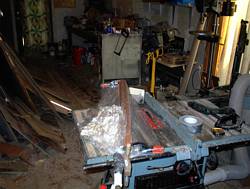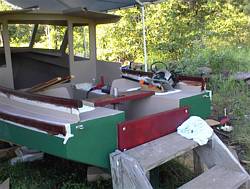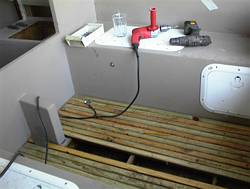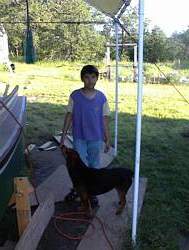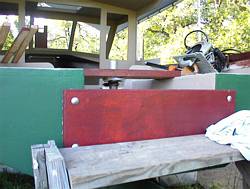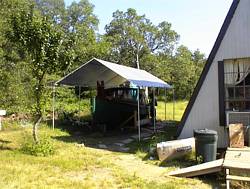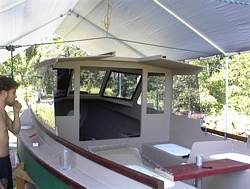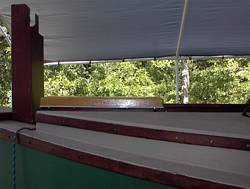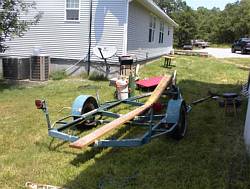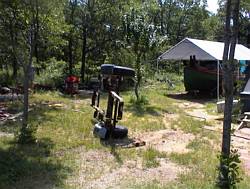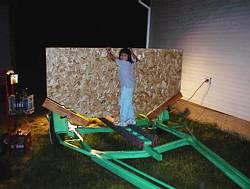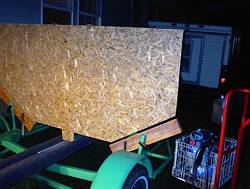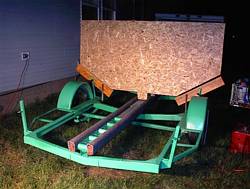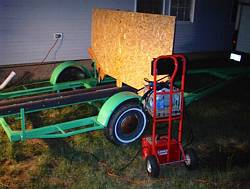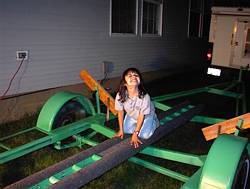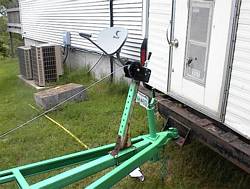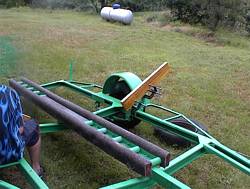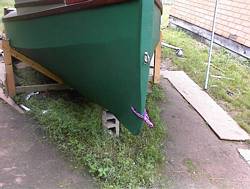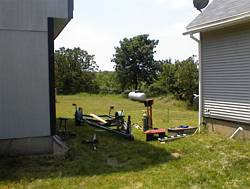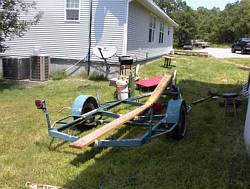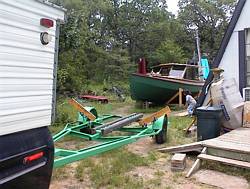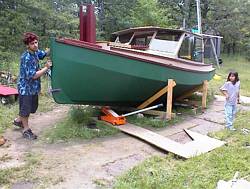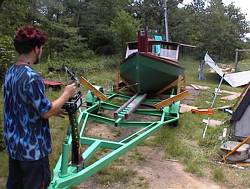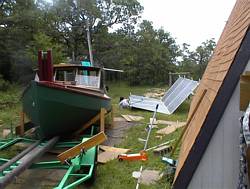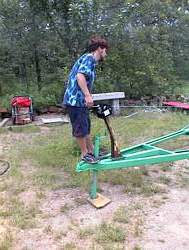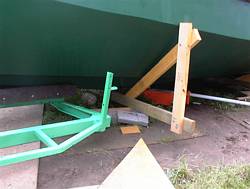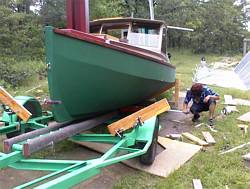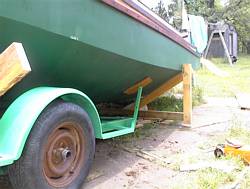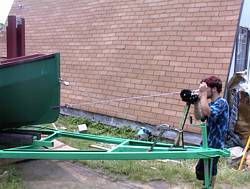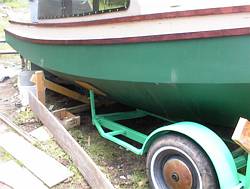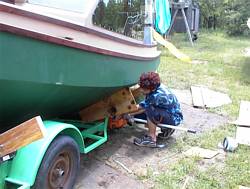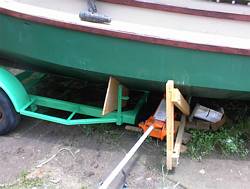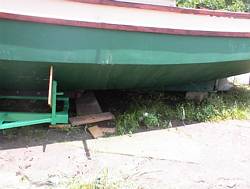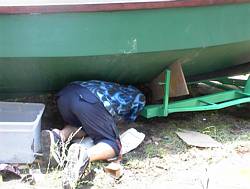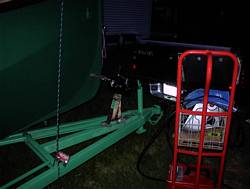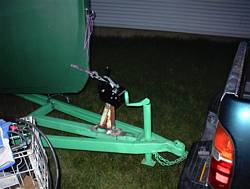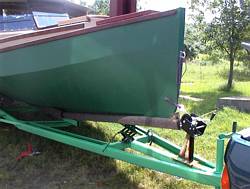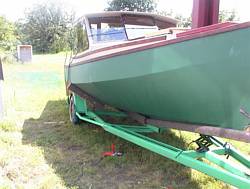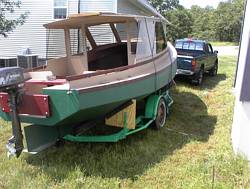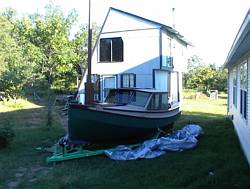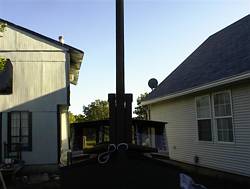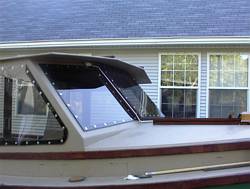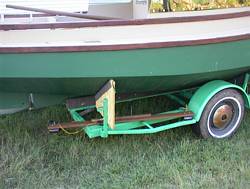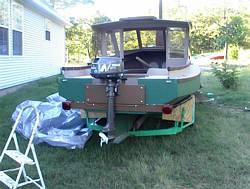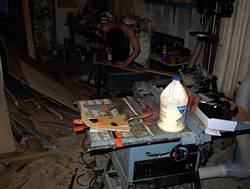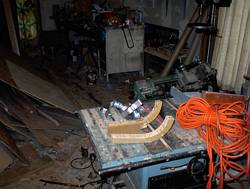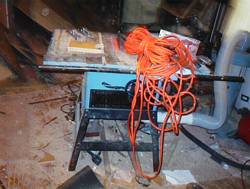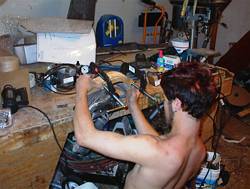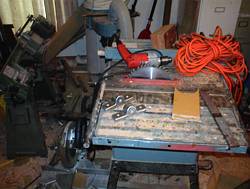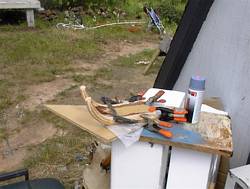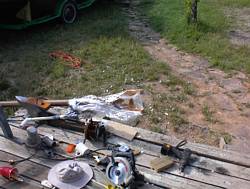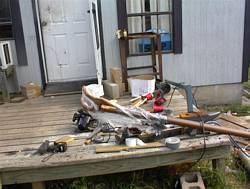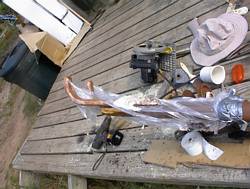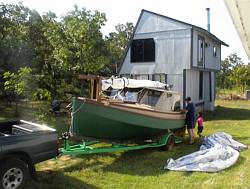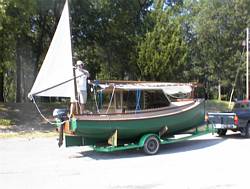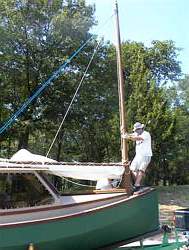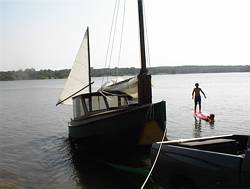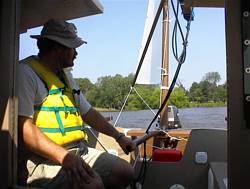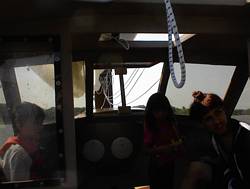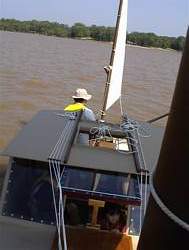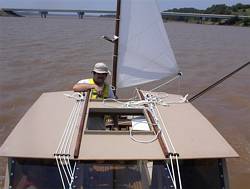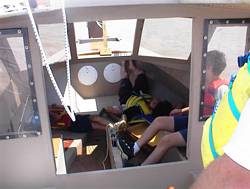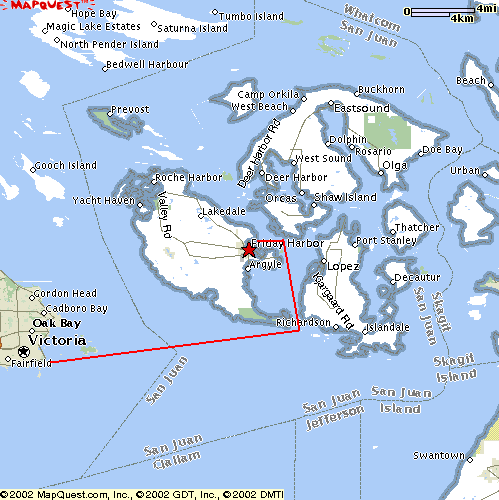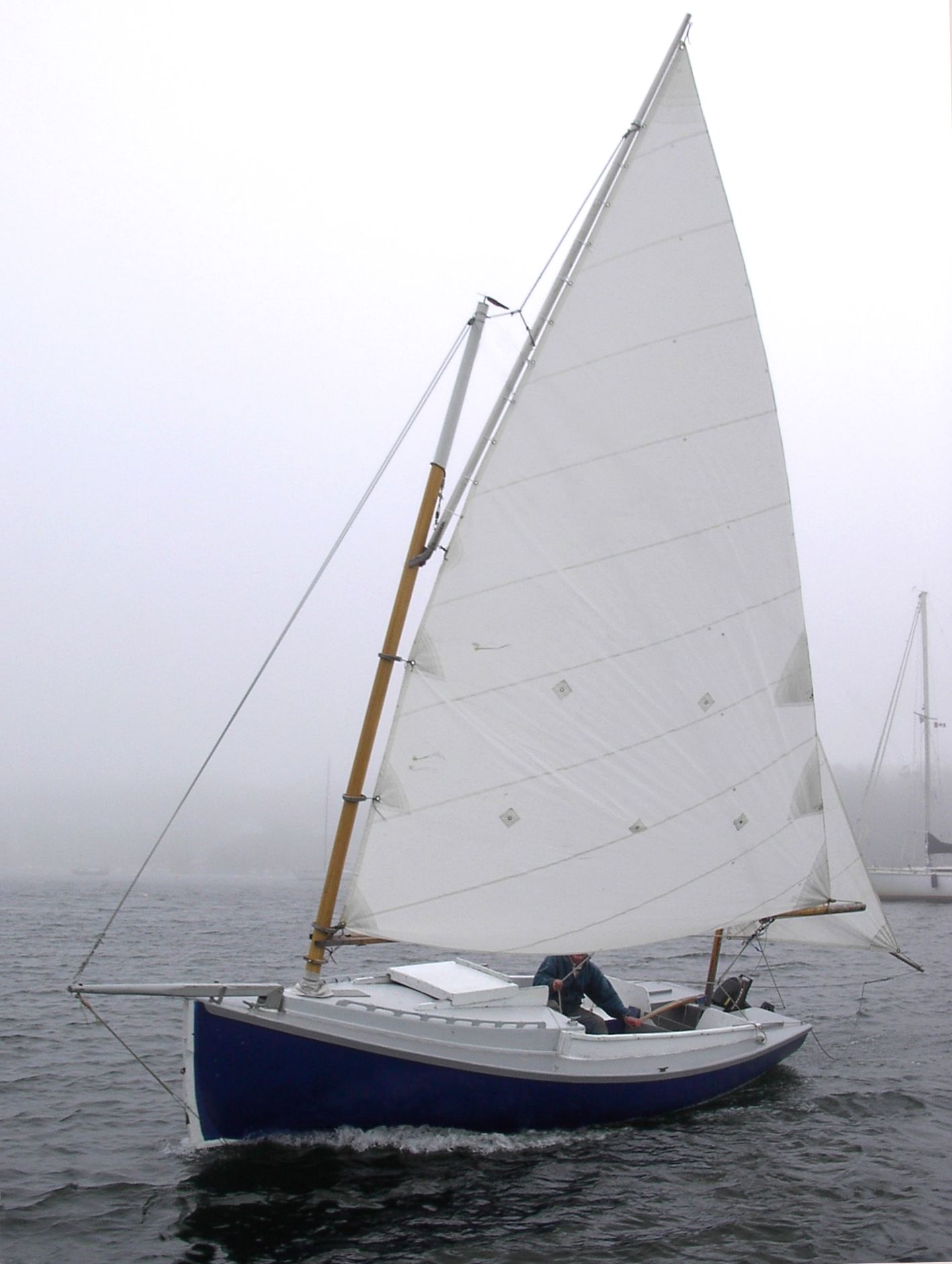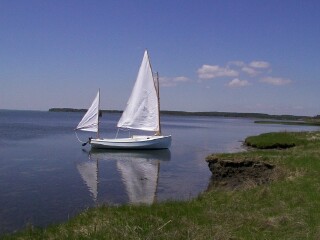Trailering (trailing?) the CLC – Richard Spelling
Lots of contributions this issue, thanks everyone.
AF2 Entropy was stolen! It was waiting in the parking lot for the new owner to take it for a sail, and someone decided if it was left in the parking lot for over a month, it must be abandoned, and took it home! And, it was sitting with seven other boats! Can I build them good or what? The guy who took it tried to register it, and the Colorado DMV said “emm, wait a second here”. Turns out he is a boat builder, and couldn’t stand to see the boat sitting in a parking lot not being used! He’s contacted the rightful ower and is trying to buy the boat.
Well, I’ve been working on the CLC for over a year. It’s done. I really don’t know how someone spends 5 years or so working on a boat project. Not to say I can’t see how one could take that long, but I can’t see how anyone could stand to work on one that long, and not feel that they had to get DONE, NOW, ERRR.. Probably just my impatience.
Made up a trailer, an interesting exercise. Solicited advice from all of the registered Chebacco owners, then went ahead and did it my way anyway! Like any good project, I had a list of requirements, things I’d learned from previous trailers, or from other people.
1) I wanted road wheels. Large, car sized tires are supposed to travel better, they turn slower and span bumps that smaller tires drop into. Important on the good roads where I live.
2) I wanted a low slung trailer. Drop axle, frame bent in the middle for a keel. I wanted the boat to sit as low as possible on the trailer and still clear the wheel wells.
3) I didn’t want a trailer 7.5 or 8 feet wide. The boat would fit on this trailer better, but there are a lot of turns you can make without hitting things with a narrower trailer. I don’t mind if the boat is a bit wider than the trailer, it’s up in the air and will clear most things a wider trailer would run into.
4) I wanted a ramp on the front for the keel to sit on. I’ve had issues with having to lift the front of the boat up to get it onto cross bunks when retrieving. I wanted to be able to just winch the boat onto the trailer.
I had an old power boat trailer sitting in the back that fit all of the these criteria, a little modification and I was in business.
We launched on a Saturday morning, hot and sticky, winds 10-15. Wonderful day for sailing. Took a long time friend of mine, David, the two smallest kids Paul and Alana, and my son Brian.
It’s really quite amazing how quick this thing is to setup. Without hurrying, and never having done it before, I had the boat in the water 10 minutes after arriving at the ramp. Remove boat tie down, remove light bar, unstrap masts, step and unfurl mizzen, hoist mast, back into water. That simple.
I need to come up with a solution for getting into the boat when it’s on the trailer, even if it’s just a couple of well placed handholds. However, the boat is suprisingly easy to get into with the nose on the beach. I was pleasantly surprised, you can put the nose on the beach, and step on shoes dry. Side walking around the pilot house to the cockpit, the boat tilts till the chine digs in, then stops dead.
Motored away from shore with the brand new Nissan 6hp. Very sweet, idling it moved us as fast as the trolling motor would move the AF2 flat out. The trim is off, I made the motor mounting board flat to the transom, so the rear of the boat digs in about 4 inches when the motor is pushing, even at the max down setting on the motor. Will make an 11 degree wedge and fix that right up. We motored out to the center of the lake at half throttle (still breaking motor in), then hoisted the main.
We had a nice breeze from the south by southwest, perfect for heading to the hiway 64 bridge. Set on a beat to the east. Boat was pointing good, it would tack through 90 degrees with no problems at all, but I didn’t push it. After we rounded the point across from the local sailing club, I started experimenting with self steering.There was a trivial amount of weather helm, 5 degrees or so. This was easily trimmed out by hoisting the centerboard a bit. Look Mom, no hands!
It was hot and sticky, but there was lots of breeze off the bottom of the main, coming through the hatches. The kids lounged about in the cabin while David and I played sailor. The boat is rock steady, and at no time was I concerned about capsizing. Which was kind of the point of building this one. You change sides when sailing, buy only so you can see what the sail is doing, your crew and passengers can stay where they want. In the puffs it heels over and kind of squirts forward.
I made the stove and john with semi flush lids, so people could sit on them. I made the cabin doors open inwards, and put catches on them. This had the effect of making the whole boat feel like one big cockpit, you could easily talk to the people in the cabin, and they had a comfortable place to sit with an unobstructed view.
We sailed up to the bridge, then turned around and started running back. The water is up quite a bit right now and I don’t think I could have made it under the bridge without dropping the mast, which I wasn’t in the mood to do on the first outing. The main doesn’t twist any more than the AF2 main did when running, even though there is no vang on the CLC.
We reached and ran all the way back to the boat ramp on the failing afternoon breeze. The boat didn’t even seem to notice the two unintentionally flying jibes. The wind is quite shifty around here, and has a tendency to shift 90 degrees without warning, especially coming back into the cove I launch from.
Sailed the boat up onto the beach, reaching with the centerboard up. A wonderful first sail, and I’m very happy with the boat!
Now, to the pictures.
On the left, we are putting on the motor mount board and the partner for the mizzen. You can see the trim masked off to recieve stain and varnish. Center I am vacuum bagging the tiller. I asked on the Bolger group if you could vacuum back Titebond II glue. I got a lot of replies arguing over the creep tendencies, and the relative strength of Titebond II vs epoxy, etc. Nobody bothered to mention that you can’t cure an air dry glue in a plastic bag…! Had to take it out and clamp it without the bag. On the right is my vacuum pump. I’m slowly learning, instead of spending $100 on the parts to fix up some old compressor, I bought this vacuum pump/compressor on ebay for $30. It pulls about 15 inches of mercury (about 7 psi) of vacuum. The manufactures website says it has a rating for continuous use at a pressure of 30 psi, so I should be able to just leave the thing on during the entire bagging process.
Left is a picture of the fancy mast locking gate. Similar to the gate that held the mast in on the AF2, simply a piece of 1/4″ stainless steel and a couple of 3/8″ bolts. On of the holes is slotted, and there is a wing nut on that side. Center is a picture of the floorboards going in. Have since added hinges to the outermost 4 boards, so I can access the bilges for cleanup.
Left is a shot of the UHMW poly bearing plate for the rudder. Holds it down and keeps it from rubbing against the boat. Right is a picture of the Lexan going on. Ya, I know, I said I was using plexiglass. Well, it cracks if you look at it wrong, or drill to fast, and the tint looked HORRIBLE. The Lexan is almost impossible to break, and I should have used it to start with.
Left is a picture of the forward sliding hatch. Right two are the raw material for the boat trailer. Note the fancy $15 welding cart.
How do you figure out the clearances for your bunks? emmm. Ah HAH. Template!
Another $15 welding cart, little helper, and temporary winch post. Note that the bilge boards, the ones that hold the boat upright, are just clamped on (with GOOD clamps) at this point. The will have to be tweaked with the boat on, and the carpet on them. Also note the nice roller arrays. Destroyed EVERY ONE of these rollers putting the boat on… Sigh, wired some carpet covered plywood over the roller axles and am trying to forget about it…
Getting ready to load boat. Not the high tech pulling attachment. Actually, this is high tech. I’ve learned though hard experience that there is this little thing called “leverage”, and that winch posts need to be short and stubby, and pull on the bottom of the boat. This is pulling on 4 turns of 5mm spectra line, going through a 5/8″ hole drilled in the solid wood of the stem. The line is almost as strong as steel, and would rip the front of the boat off before breaking. The 1/2″ stainless U bolt is for if I ever need a tow, and makes a nice solid attachment for an anchor line.
On the right we are backing the trailer up to the boat. To the left of the right hand picture is my pair tree which condescended to give us a single pair last year. For it’s generosity, I didn’t cut it down to get the boat out.
Didn’t feel like spending the time or money to rig something up to lift the boat up for rolling the trailer under it, so we winched the boat onto the trailer. On the left we are moving the front of the boat over to line up with the trailer, right two we are just starting to winch it on. We took our time, took lots of breaks, and checked clearances often. Took about 4 hours for the entire operation.
Crank, crank. Remember what I said about leverage? We almost pulled the heads off of two 3/8″ carriage bolts, and started to pull two welds apart. Of course, if our rollers hadn’t disintegrated on us, and we hadn’t been dragging the keel over a bunch of steel axles… Center, we are about to remove the forward half of the building cradle. Jack is under to lift boat for adjusting the set on the trailer.
Front cradle removed, aft bilge support posts on trailer keeping the boat from tipping over now.
Cradle gone. Temporary aft bilge support boards screwed in place. Center Brian is unscrewing the board that was holding the centerboard up. Right, on the trailer and ready for tweaking.
Final, stubby, winch post. Right is a picture of the forward keel ramp and support.
More pictures of the keel ramp. Pictures of the bilge supports in the back. No way the boat can slide off backwards now, has to float up and over the aft bilge support boards first.

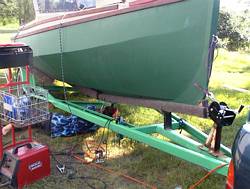
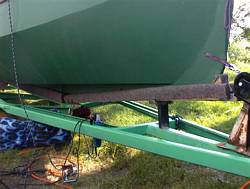
Idea! Teach teenager to weld, so he can crawl under the boat trailer and weld braces on. Am I smart or what?
Mast going on, right is the fancy, high tech, attachment system for my center window.
Light board. Technically, I probably could have just put reflectors on the back of the boat, and left the lights attached to the trailer. However, the smokeys around here have a tendency to give you tickets if they even THINK you are outside the law. I could quote statutes at them, but…. Center, light board is attached. Payed extra, bought LED, submersible, trailer lights. If they save me a ticket for a burned out light bulb, they will pay for themselves. Right is the parts for the gaff saddle. The geometry says it needs to turn 90 degrees on a 4 inch radius to fit under the mast when folded, fit against it when hoisted, and fit perpendicular when down.
Of course, I made my tabernacle to short, so the gaff won’t fit under the mast when folded… not sure what happened there. Not a big deal to pull it off and tie it to the side, though.
Decided on ply laminations for the saddle, instead of spending the time and effort to do one up of steamed oak or whatnot. I’m toying with redoing the gaff hollow and extremely light, which will require a new saddle anyway. Next to the saddle on the tablesaw are the castings for the gooseneck for the boom. It’ll be stainless turing in aluminum, but I’ll keep it oiled and hope corrosion doesn’t screw it up two bad.
Castings after machining, jaws with sides attached. Vacuum bagging the thing.
Nice thing about vacuum bagging is it pulls all the glass down to the odd corners. Right, David and Alana inspecting the boat on launching day.
Stepping the mizzen. Hoisting the mast. I have to pull and close the gate at the same time because the lazy jacks are lifting the boom and gaff up.
It didn’t sink! To the right, native swimming and playing with a canoe. On the boat ramp. Next to the sign saying “Don’t swim in boat ramp area.”
Me at the helm, motoring out. Passengers in the cabin. Note the reefing and halyard lines.
Reaching back to the ramp. Note the passengers napping in the cabin. Lots of room, cool in the heat. Also note the two access ports to the anchor bay. Thrifty Marine finally came through with the deck plate there were sending me to “make up for” the $18 order I had to threaten them to get shipped.
All in all, I’m very happy with the boat, and I think the trailer turned out wonderful. I have since hooked up the solar panel and the lights, and we are taking the boat out on the 4th to watch the fireworks at the lake.
– Chebacco Richard.
***
The cruising season is OPEN! – Jamie Orr
Hi Richard
Wayward Lass kicked off her 2002 cruising last weekend with a short trip to Friday Harbor, on San Juan Island, part of Washington State. If you go to http://www.mapquest.com/, enter Friday Harbor, WA, in the search box, then click on “big map”, you should get a good view of the area. In fact, if you draw a line from the bottom left corner of Vancouver Island, to the pass between the islands below Friday Harbor, draw another line from that pass north, then west to Friday Harbor, you will have our route over, exactly.
Three of us were travelling over to an afternoon of Scottish country dancing in Friday Harbor — my wife Maureen, our friend Anita and myself. The forecast for Haro Strait to the east was good, with light to moderate winds, the one for Juan de Fuca to the south was not so good, strong winds were forecast, a small craft warning for later in the day. (Our track took us right along the line where the two Straits touch.) Since we would be there by noon, I decided we could go ahead, but I had some reservations about the trip back on Sunday, as the Juan de Fuca outlook was for stronger winds.
We got away from Oak Bay Marina at 7:15 am, pushed along by our 5 hp Honda. There was quite a tide moving around the end of Vancouver Island, and it was kicking up a few waves. However, once past Discovery Island, visible on Mapquest just under the “a” in “Victoria”, it quieted down and we turned into the wind to put up the mainsail. Unfortunately, the wind wasn’t strong enough to fill the sail with the motor running, and we needed the motor to meet our deadline, so after a few minutes we took it down again.
The south end of San Juan was hidden in fog. I had a course plotted on the chart, with allowance for the tide pushing us south, but also had waypoints entered on the GPS — I went with the GPS, keeping the chartwork for backup. Traditionalists will be pretty disgusted so far, what with using both engine and GPS. That’s a shame, because that’s pretty well what the trip over consisted of. I will say that our planning was sound, in that we avoided the small craft warning, but we hit some big waves south of San Juan, resulting in some pounding. Maureen was napping in the cabin, and got some air time off some of the waves. Luckily, what little wind there was threw the spray the other way, so we stayed dry and enjoyed the mini-rainbows. After the turn north through the pass, we got a good boost from the tide, making good speed to Friday Harbor.
Once there, we landed at the customs dock and phoned the office. Since Wayward Lass and I are in the system already, we were able to clear over the phone, so were free to go and arrange a berth for the night. The we all went off to the dance and a barbecue after. Later, Maureen and I slept aboard while Anita was billeted with a local dancer. The marina is big, and was noisy in the evening, but quieted down after dark and we had a good night’s rest. I recommend it as a well run place, but it’s kind of like living in a floating city.
Next morning, there was a small craft warning for the eastern end (our end) of Juan de Fuca, but Haro was still just fine. Being on the cusp, as it were, I didn’t know what to expect once through the pass at the bottom of the islands, but thought we’d better go and see. If it was too rough, I could always come back and put my passengers on the ferry. We set off at 8:45 so as to arrive at the pass at 10:00. We needed to go through before the tide turned, but didn’t want to catch the strongest part of the ebb because we’d be fighting it once we turned west. As we approached the pass, we were all dressed for the worst, but as we came out into Juan de Fuca, we found ourselves enjoying a sunny summer day.
There was a nice south east breeze, so we put up the sails, and stripped off all the foul weather gear. I guess Juan de Fuca is a big piece of water, and our little corner was well away from any stormy weather. We planned to hug the shore to work our way north before crossing Haro Strait,so that the ebb would not carry us to the south, and this worked very well, we found an eddy that helped us on our way for about 6 miles along the San Juan shore.
(We went north about level with the printed “Gordon Head” on the Vancouver Island shore before we crossed.) When we finally struck out into the Strait, the ebb came from slightly behind us, and we made an excellent crossing. We motor-sailed until I was sure of making the northern entrance to Oak Bay, then shut down the motor and enjoyed the quiet.
The northern entrance, Baynes Channel, and I don’t get along very well — again I found I was fighting the tide there. I’d misjudged the turn so we had to start the motor again to get in, but after such a good crossing, I could live with it. Once at the marina, we called the Canadian customs, who also cleared us by phone.
A good start to the season — sunshine and only a few waves. I know from personal experience that that stretch of water can be very uncomfortable, so I was relieved not to have to fight our way home. The plan is for Maureen to keep enjoying these little trips, and only be exposed to rougher weather once she is at home on the water — wish us luck!
PS I hope the reference to Mapquest helps — let me know if it did or not.
Thanks.
***
Chebacco Sailrite – Fraser Howell
Here is a picture of Itchy & Scratchy wearing her new Sailrite main.
This sail differs slightly from the stock sail. It is loose footed, with
an extra 6 in. round in the foot, the draft is slightly less, and the
maximum draft is slightly further forward. The sail sets well. The boat
tacks through 90 degrees, beats faster with less weather helm. The
sailrite kit was well assembled, and the directions were clear. The
thing went together in about 30 hours, almost all with a standard home
type sewing machine.
The deepest draught is 8%, 30% aft. The previous sail had 6 hard seasons. It was rarely reefed. max draft was increased quite a bit. Windward ability was severely reduced. The weather helm is now greatly reduced. I go upwind with the board fully down. The old sail needed about 10 degrees of weather helm, the new one, 5 or less. Hit 9 mph on a broad reach by Garnin E trex. maintained 7-7.5 in winds just shy of whitecaps.
Glad you are keeping up the newsletter, it is still a good read.
cheers
Fraser Howell
***
I get my kicks from Champlain – Phil Mead
I had planned Father’s day weekend with my son, Adam. We were going to sail
his boat, a Capri 14.2 I purchased used and refinished for him, but the
weather washed out our plans. Since I was dying for a sail, it seemed like
a good time to go solo aboard Legacy. Naturally, it decided to keep raining
like mad, but I was determined to go fair weather or foul, so I headed
north from Concord along I-89 to Mallet’s Bay on Lake Champlain. I have a
Shore-Land’r trailer with the widest allowable wheelbase and it tows and
launches the boat beautifully. Since I wasn’t fully rigged-up, I spent the
first two hours under my stepped mast bending on the main to the gaff and
attending to various details. It continued to pour until evening then
stopped like someone shut off a faucet. I decided to chance a quick evening
sail because I’d not been on the water with Legacy since last fall.
Legacy was wonderful in the very light evening airs, she ghosted along with
such a nice little gurgle under her hull, she had me singing.(I think the
gurgle sounded better!).
Mallet’s Bay is really two bays. A small inner bay and a much larger outer
bay. The bay is formed by a motor causeway to the north and an abandoned
train causeway to the south. Father’s Day dawned with heavy clouds but only
very light rain. The wind piped up nicely from the south, so I decided to
sail (without mizzen) the outer bay area. When I set out, I was the only
sail on the horizon. despite the relatively moderate conditions. Later a
couple of larger boats, 30-35 footers joined me.
I took a long, broad reach north past beautiful sandstone and limestone
cliffs that dropped straight into the harbor. I think the Chebacco’s are at
their finest on these points of sail. With only half the center board down,
there was very little tendency to yaw. I was really boiling along and past
a number of trolling fisherman, so I estimate I was making about five
knots. As I neared the northern causeway, white-caps were appearing so I
decided it was time to turn about and beat my way back. Champlain kicks up
a lot of short and choppy waves but the full keelson breaks them up nicely
and really reduces the slamming on the flat bottom. I had little trouble
going to windward despite the absence of the mizzen although I’m sure it
would have driven her better. There was a slight tendency to stall if I
tried to point too high so I let her back off on her own then “cheated”
upwind when it gusted. A couple of the gusts caught me when I was sitting
on the lee side, but once that chine hits the water she really doesn’t want
to go over any farther. At no time did I fear a capsize.
The launch ramp ( the Vermont Fish and Game maintain wonderful ramps and
they are free!) was on the south shore so I beat my way in as far as it was
safe to, then found a small cove to drop the main. Here’s where I found out
I wasn’t as spry as I use to be. Running up to the foredeck made me glad I
didn’t do any cabin modifications, but I think I’ll bring all the running
rigging back to the cockpit before I set out alone again. I managed to
avoid any collisions with the cliffs or any the the many, many boats at
anchor and got safely back to the slip. I actually love the part where I
take Legacy out of the water and I think I’ve found a nifty way to do this
without assistance. I simply tie on a long mooring line to the Jonesport
cleat and the aft cleat and walk it on the the trailer standing off to one
side. She’s so light she floats to within a foot or so of her resting
position on the trailer.The rest is easy.
I hope to make Lake Michigan Legacy’s next big lake adventure. I’m trying
to talk Frank (my father the builder) into a longer cruise. He doesn’t
think he’ll get his 22′ double-ender, Song of Ruth (a strip built design)
in the water this year and wants to sail with me. Frank is busy building a
small pulling boat for my sister, so I may have trouble getting him out of
the shop and onto the boat, but I don’t think he’ll really be able to
resist. Good sailing to you all, Phil
***
Take one homemade boat – Pat Spelling
Take one homemade boat, a little wind, 2 adults, one teen and two children, pop and junk food and you get one relaxing Saturday evening—even if you DON’T like to sail.
It was my first voyage out on Schrödinger’s Cat, Hubby’s new Chebacco boat. It was the second sail for the boat itself. We attracted the usual admirers as we put the boat in the water. I have noticed that homemade boats never fail to attract favorable attention, no matter what they look like. Anyone who knows me knows that I am NOT a fan of sailing. I never could figure out how to sail and fish. Those ropes get in the way every time and periods without wind make me want to climb the walls, or the very least jump overboard and swim to shore. But tonight we were blessed with a nice steady breeze.
I like the design of the Chebacco in many ways. They say that people choose pets that look like themselves. Well, I think that the Chebacco looks like Richard in many ways. It has a sort of scowl to it. Hubby has a square face and his eyebrows meet and that is the effect of the front windows. The Cat is wide, yet low and sleek, something his last boat, Entropy was not. Entropy was not a bad boat, though at times it reminded me of a floating casket.
I do have to admit that sailing in this vessel was a pleasure. For one thing, the passengers are no longer ballast!! I can now enjoy a book while I ride. The seats are comfortable and the cabin enjoyed natural ventilation. When we launched the temperature was 90 degrees and yet we stayed cool. The last boat had a flat bottom and the continual pounding made conversation all but impossible. This design has a flat bottom too but the pounding was minimal. I also appreciated the spaciousness, even with five of us, we were never crowded.
Now, being married to a absolute boat nut, I hear about boats in every sentence except when this man is sleeping. I have seen more than my fair share of boat designs. I have been asked to give my opinion on many designs. My hubby is an optimist. Hoping that I might be bitten by the “boat bug”. I haven’t,but I am not blind and I do appreciate good design. I am grateful that Susanne Altenburger has added some style to the otherwise bland box designs that are out there. While I probably won’t be the first to suggest that we go sailing, I probably will enjoy the times that we do all go sailing now, thanks to this new cool cat,Schrödinger’s Cat that is!!
-Pat Spelling
***
For Sale – Sheet ply Chebacco
How’s it going? I wanted to let folks know about my decision to sell my Chebacco. I really love this Catboat but I love my girlfriend more and want to pursue that a while. The boat is built exactly to Phil’s Specs. The trailer was purchased new for $1,300 a couple of years ago and the 1997 Force five hp. Outboard was purchased new for $800 as well (it sat on the showroom a long time I guess). The sails were purchased as a kit from sail-rite, the mainsail being sewn by a professional, and the mizzen sewn by me since it was small and manageable. I launched this boat for the first time in April of this year and have taken one two week trip and several small day trips so far. There are a few normal scratches on the hull and the spars but nothing out of the ordinary. The hull is planked in Douglas Fir Marine plywood and the floors and roof framing are Douglas Fir. There are a couple of floors made of Southern Yellow Pine and the trim is all White and Red Oak. The sliding hatch was cold molded and then veneered on the inside and out with White Oak as were the drop boards – no sign of wear on any of these components. All trim and spar varnish was Epifanes WoodFinish Gloss and it shows.
Bill Samson listed his for 4,500 lbs. Sterling which is approximately $6,500 I think. I would like to ask $6,500 to start and see what happens.
Thanks Richard.
Pete Respess
Hopewell, VA
***
For Sale Lapstrake Chebacco 20
LOD: 19′ 6″
Beam: 7′ 10″
Draft: 1′ 0″
Sail Area: 176 sq. ft.
(Lots of wonderful pictures here -Ed)
Built by an experienced amateur. Over four thousand hours building time. The best of materials used. Finished with two-part polyurethane. Sprayed by a professional. Bright work finished with Norwegian varnishing oil (between six and eight coats).Hull is built of 7 ply half-inch marine mahogany plywood; keel is built of same material, laminated to proper thickness.The keel is covered with double thickness of 11 oz. fibreglass cloth saturated with epoxy. 1/16 inch stainless steel was then attached to the bottom of the keel and up the stem as far as 22 inches above the waterline. Outside of boat is covered with 11 or 6 oz. fiberglass cloth which was then saturated with epoxy, then an additional four to five coats to allow for sanding to a mirror finish before painting. Inside has four coats of epoxy.Spars are solid sitka spruce. Fittings are all top quality such as Harken or custom made of bronze or stainless steel.Three sails (main, jib, and mizzen.) All lines, sheets and halyards ready to go. None of them ever used.Custom made trailer with extendable tongue for easy launching. Elaborate supports that fit to cabin and aft cockpit bulkhead to hold spars for long distance trailering.No O.B. motor. (4 to 5 HP would be suitable.)The boat was completed Sept.2000 but ill health precluded launching and am selling the boat now for the same reason.Price $12,500 USD(See article in Wooden Boat – #107, Pg. 80)Address:
George Cobb,
186 Gallagher St.,
Shediac, N.B.,
Canada, E4P-1T1
Email: gcobb@nbnet.nb.caPhone: 506-532-0007


